British and European Car Spotters Guide - 1959 |
|
|
 |
|
|
|
It was estimated, in the autumn of 1959, that one in every three families in Great Britain owned a car. With attractively-priced new models reaching the showrooms and production figures continuing to rise rapidly, the position looked encouraging as Britain prepared to move into the sixties. Of the year's total car production of 1,231,414, no fewer than 568,971 were exported, valued at £222,531,517; UK registrations accounted for 662,443 (including hackneys). The number of imported cars had also risen-26,998 compared with 10,940 for the previous year. Apart from anything else, 1959 was the year of the Mini. This incredible little car started its very successful run in the summer and was an immediate hit with rich and poor alike. Also new to the public were the Aston Martin DB4, the BMC 1½-liter 'Farina' range, Bristol 406, Daimler SP250, Rover 3-liter, Sunbeam Alpine and Triumph Herald. |
 |
 |
 |
Export British Cars of 1959 |
| |
|
| |
Pictured left is an assembly of most of the British car types available for purchase in the United States of America in the early part of 1959. |
|
 |
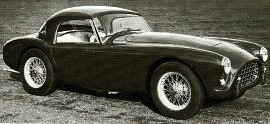 |
 |
AC Ace |
| |
Also see: AC Car Reviews | The History of AC (AUS Edition) |
| |
The AC Ace with hard-top joined the Ace open sport and Aceca models which were continued without material changes. The fiberglass hard-top was detachable. Approximately 90 per cent of AC cars were exported, mainly to the USA. |
|
 |
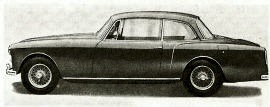 |
 |
Alvis 3-liter TD21 Park Ward |
| |
Also see: Alvis Car Reviews | The History of Alvis |
| |
The Alvis 3-liter TD21 Park Ward-bodied Saloon was distinguished from the TC1 08/G (Graber) version by a more curved bonnet top and nose, smaller one-piece rear window. number plate on the rear panel and revised frontal treatment. A Drophead Coupe version was also available. The 2993-cc engine was given a six-port cylinder head. new carburetors and a revised exhaust system early in the year. |
|
 |
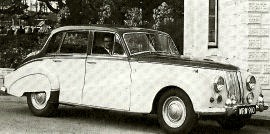 |
 |
Armstrong Siddeley Star Sapphire Six-light Saloon |
| |
Also see: The History of Armstrong Siddeley |
| |
The Armstrong Siddeley Star Sapphire Six-light Saloon was similar in appearance to the Sapphire 346 except that it had cutaway rear wheel covers, doors hung on concealed hinges at the leading edges, a Sphinx mascot on the bonnet and different frontal treatment. The car featured a new 3·9-liter six-cylinder engine, automatic transmission, servo brakes (discs on the front) and power-assisted steering, all as standard equipment. |
|
 |
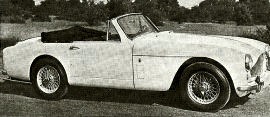 |
 |
|
| |
Also see: Aston Martin Car Reviews | The History of Aston Martin |
| |
The Aston Martin DBIII Drophead Coupe and Saloon were conntinued with modifications which included a hydraulic booster for the braking system and an alternative choice of-2922-cc-engine: a Special series engine with three SU carburetors or Competition engine with three Weber carburetors A Fixed-head Coupe with the Special series engine and twin exhausts as standard was added in the late spring, but by the autumn all three versions were discontinued. |
|
 |
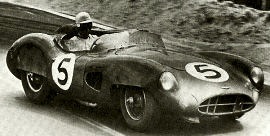 |
|
 |
 |
 |
|
| |
Also see: Aston Martin Car Reviews | The History of Aston Martin |
| |
The Aston Martin DB4 Saloon was a close-coupled four-seater, styled by Carrozzeria Touring of Milan and built by Tickford in England. The impressive car had a sloping roof which merged neatly into the tail that housed a completely separate luggage boot-the first post-war Aston Martin in which the boot did not link with the passenger compartment-and a traditional Aston Martin front end. The 3·7-liter six-cylinder engine, which was a direct development from the 'Le Mans-bred' OBR2/370 unit, developed 240 bhp at 5500 rpm. |
|
 |
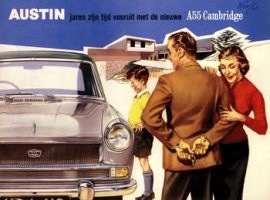 |
 |
Austin A55 Cambridge Mark II Farina Saloon |
| |
Also see: Austin Car Reviews | The History of Austin (AUS Edition) |
| |
The Austin A55 Cambridge Mark II 'Farina' Saloon. This new Saloon - available in either standard or de luxe form - featured bodystyling by Pininfarina of Italy, using straight lines and finned rear wings. The well tried 1489-cc BMC B-Series engine, which was continued with a number of modifications, developed 53 bhp (gross) at 4350 rpm. A Countryman estate car version was added in the following year. |
|
 |
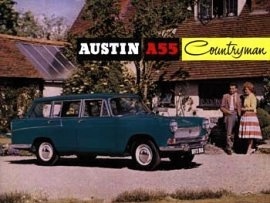 |
|
 |
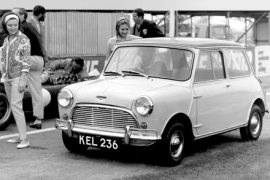 |
 |
Austin Mini |
| |
Also see: Austin Car Reviews | The History of Austin (AUS Edition) |
| |
Hardly needs introduction as a design icon, but the original Mini's transversely-mounted front engine freed up a remarkable 80 percent of the tiny car's length for interior space. Groundbreaking stuff. |
|
 |
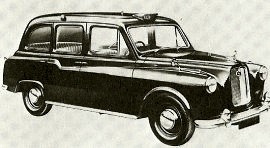 |
 |
Austin Taxi Model FX4D |
| |
Also see: Austin Car Reviews | The History of Austin (AUS Edition) |
| |
The Austin Taxi, Model FX4D, was introduced in mid-1959. It had a redesigned body, a 2·2-liter diesel engine and optional automatic transmission. The Hire Car version was designated FL2D. |
|
 |
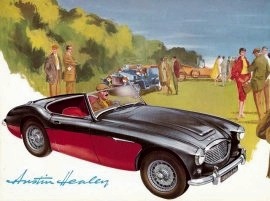 |
 |
|
| |
Also see: Austin Healey Car Reviews |
| |
The Austin Healey 3000 was introduced in 1959. The 2912 cc engine produced 132 hp which was later increased to 150 hp. It retained the detachable sliding windows; the Mk 2 was fitted with wind-up windows and a new windscreen arrangement. |
|
 |
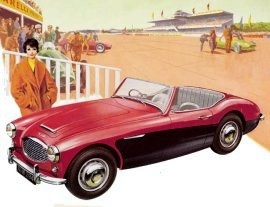 |
 |
|
| |
Also see: Austin Healey Car Reviews |
| |
The Austin-Healey 3000 Sports Roadster, Model BN7, superseded the 100 Six. It was distinguished by a '3000' flash on the horizontal slatted radiator grille and featured a larger (2912-cc) six-cylinder engine which developed 132 bhp (net) at 4750 rpm, a new front suspension system, and front disc brakes as standard. Also available was a two/ four-seater (BT7) version. |
|
 |
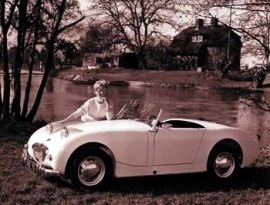 |
 |
|
| |
Also see: Austin Healey Car Reviews |
| |
In 1959 few sports cars were more endearing that
the Austin Sprite. It earned the nickname of " Frogeye"
due to its pop-eyed headlights and somewhat gaping grin. It captured the hearts of 3000 Healey enthusiasts all
over the world being a rather chirpy character on the
road with a top speed of 135 km/h. Assembled at Abingdon, it was based on a simple but
sturdy steel unit construction shell the Sprite had
immense character, acceptable performance, direct steering
and good handling, all for a very (at the time) purchase
price. |
|
 |
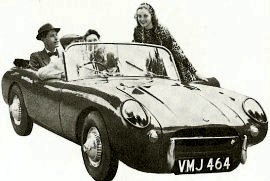 |
 |
Berkeley Foursome Sports |
| |
|
| |
The Berkeley Foursome Sports was developed from the 492-cc engined two-seater, and was introduced in the autumn of 1958. It was also available with hard-top. The two-seater models were continued under the Twosome label. By March 1959, however, the complete range was discontinued and replaced by a new model. |
|
 |
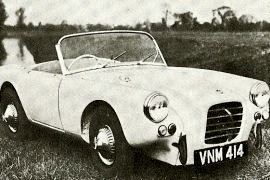 |
 |
Berkeley B95 Sports and Hard-top |
| |
|
| |
The Berkeley B95 Sports and Hard-top were powered by a Royal Enfield four-stroke two-cylinder 692-cc 40-bhp engine and externally differed from the earlier models mainly by the modified front. A B1 05 version, also available, had a higher performance engine (50 bhp at 6250 rpm). Larger-bodied versions (OB) were also made. |
|
 |
 |
 |
Bristol 406 Saloon |
| |
Also see: Bristol Car Reviews |
| |
The Bristol 406 Saloon had a completely new aerodynamically styled two-door body-built by Jones of Willesden-as well as a larger 2·2-liter 105-bhp six-cylinder engine and servo-assisted disc-brakes all round. The luxurious interior included reclining seats with hinged headrests. |
|
 |
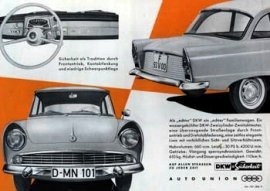 |
 |
DKW Junior |
| |
Also see: Auto Union Car Reviews | The History of Auto Union (AUS Edition) |
| |
The DKW Junior prototype was first exhibited in 1957, and featured a two cylinder 660cc two stroke engine engine reminiscent of the two stroke engine last seen in the DKW F89 Meisterklasse phased out in 1953. A new manufacturing plant was constructed at the company's Ingolstadt location for production of the car, and by the time the Junior went into production, the prototype’s engine had been replaced by a three cylinder two stroke unit of 741 cc for which an output of 34 bhp (25 kW) was claimed. It is not clear whether the DKW Junior de Luxe, introduced in 1961, was intended to replace or to complement the original Junior which, in any case, was withdrawn in 1962. The Junior de Luxe had its cylinders bored out: total displacement was now 796cc. Claimed power output was unchanged but the torque was marginally increased and the wheel size grew from 12 to 13 inches. Claimed maximum speed increased from 114 km/h (71 mph) to 116 km/h (72 mph). In January 1963 the Junior De Luxe was replaced by the DKW F12. Outwardly there was little change, but the C pillar became more angular and the engine was enlarged to 889cc which was reflected by a claimed increase in output to 40 bhp (29 kW). Apart from the engines, the big news from the F12 involved the brakes: the F12 was the first car in this class to be equipped with front disc brakes. In August the Junior’s 796 cc engine reappeared in the DKW F11 which was in effect a reduced specification F12. The DKW F12 roadster which appeared in 1964 extracted 45 bhp (33 kW) from its 889cc three cylinder engine, and this more powerful unit became available in the F12 saloon for a few months from February 1965. Early in the summer of 1965 Volkswagen acquired the Auto Union business from Daimler Benz: production of the two stroke DKWs was almost immediately terminated. In the market place the DKWs had been facing an increasing struggle to compete with similarly sized more powerful four stroke engined offerings from Volkswagen and, more recently, Opel. By the end of 1965 the plant formerly controlled by Auto Union was building Audi badged cars, with four cylinder four stroke engines designed, before the change of ownership, in collaboration with Mercedes Benz.
|
|
 |
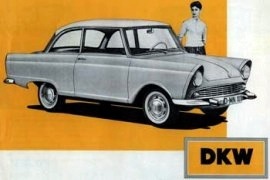 |
 |
DKW Junior |
| |
Also see: Auto Union Car Reviews | The History of Auto Union (AUS Edition) |
| |
The DKW Junior was a small front wheel drive saloon manufactured by Auto Union AG. The car received a positive reaction when first exhibited, initially badged as the DKW 600, at the Frankfurt Motor Show in March 1957. The ‘Junior’ name was given to the (by now) DKW 750 in 1959 when the car went into volume production, but failed to survive an upgrade in January 1963, after which the car was known as the DKW F12. In addition to the saloon, a pretty ‘F12 Roadster’ (cabriolet version) was produced in limited numbers. The car was known for its two stroke engine. A number of European auto-makers produced two-stroke powered cars in the 1950s, but by the time the DKW Junior came along, the market was beginning to resist two-stroke powered cars as the industry increasingly standardised on four stroke four cylinder units which accordingly were becoming cheaper to produce. Two stroke engined cars were perceived by some as rough and noisy by comparison. |
|
 |
 |
 |
|
| |
Also see: Daimler Car Reviews | The History of Daimler (AUS Edition) |
| |
The fabulous Daimler SP250 Sports two-seater was announced in the spring of 1959, initially for export only with left-hand drive (SP250 LH Dart) and represented something of change for the Daimler company. The powerful 2½-liter V8 engine, which developed 140 bhp at 5800 rpm, made the car a particularly exciting performer. Disc brakes were standard, and overdrive or automatic transmission optional equipment. Wheelbase was 7 ft 8 in. |
|
 |
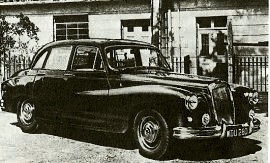 |
 |
|
| |
Also see: Daimler Car Reviews | The History of Daimler (AUS Edition) |
| |
The Daimler Majestic Saloon was similar in appearance to the One-O-Four but with increased body width, a lower radiator, smoother rear wing line and detail differences. The six-cylinder 3·8-liter engine developed 147 bhp at 4400 rpm. Automatic transmission and disc brakes were standard. |
|
 |
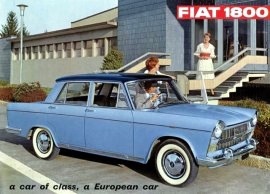 |
 |
Fiat 1800 |
| |
Also see: Fiat Car Reviews | The History of Fiat |
| |
The Fiat 1800 appeared in 1959, offered as a 4-door sedan and a 5-door Station Wagon (Family). The 1800 model had a 6-cylinder in-line engine with 1795 cc and a power output of 75 hp / 55 kW delivered through a 4-speed transmission. Its maximum speed was, depending on the version, 137 km/h (85 mph) - 142 km/h (88 mph). This was replaced in 1961 with the 1800 model B: the engine output was now 81 hp / 60 kW and top speed between 143 km/h (89 mph) - 146 km/h (91 mph). |
|
 |
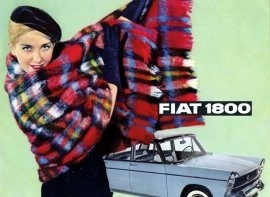 |
|
 |
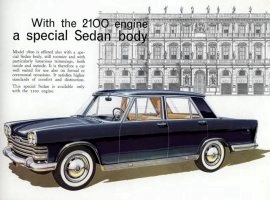 |
|
 |
|
|
 |
|
|
 |
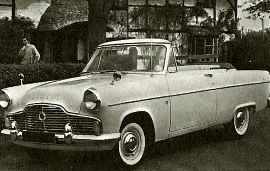 |
 |
Ford Consul, Zephyr and Zodiac Mark II |
| |
Also see: Ford UK Car Reviews | The History of Ford |
| |
The Ford Consul, Zephyr and Zodiac Mark II models underwent a number of styling changes early in the year, including a lower roof line, stainless steel surrounds to windscreen and rear window cappings, chrome headlamp bezels, restyled rear lamp clusters and a modified facia layout. Pictured left is a Zephyr Convertible. |
|
 |
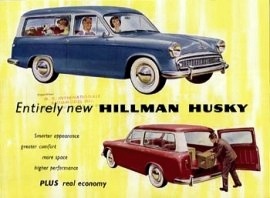 |
|
 |
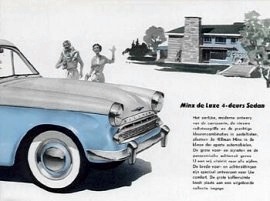 |
 |
Hillman Minx Series III |
| |
Also see: Hillman Car Reviews | The History of Hillman (AUS Edition) |
| |
The Hillman Minx Series III models featured a larger engine-1494-cc, 52·5 bhp (gross) at 4400 rpm-and differed externally from the Series II mainly by the revised radiator grille. Shown is the Special Saloon; also available were a De Luxe Saloon, Connvertible and Estate Car. The 1390-cc Husky Series I was continued unchanged. |
|
 |
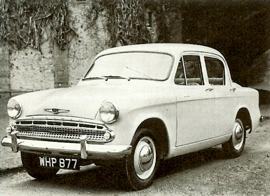 |
|
 |
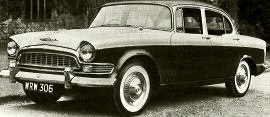 |
 |
Humber Super Snipe Series I |
| |
Also see: Hillman Car Reviews | The History of Hillman (AUS Edition) |
| |
The Humber Super Snipe Series I was a new car, using the same body shell as the Hawk but with a distinctive radiator grille and winged bird motif on the bonnet. It was powered by a 105-bhp 2651-cc six-cylinder engine with a new three-speed gearbox and featured servooassisted brakes. Also available were Touring Limousine and Estate Car versions. All had 9 ft 2 in wheelbase. |
|
 |
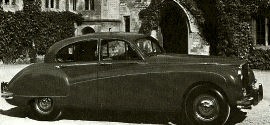 |
 |
Jaguar Mark IX Saloon |
| |
Also see: Jaguar Car Reviews | Jaguar - A Racing Pedigree | The History of Jaguar |
| |
Although outwardly identical to the Mark VIII, except for the rear-end motif, the Jaguar Mark IX Saloon had numerous mechanical differences, including a larger six-cylinder engine-twin-carburetor, 3781 cc. 220 bhp-power engine, assisted steering, and disc brakes all round. Automatic transmission or overdrive were optionally available. |
|
 |
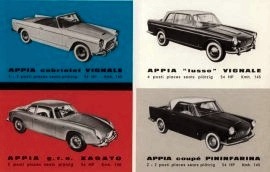 |
|
 |
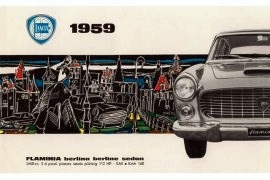 |
|
 |
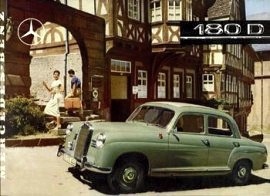 |
|
 |
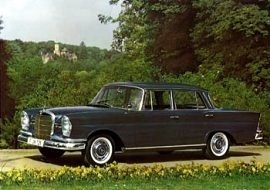 |
|
 |
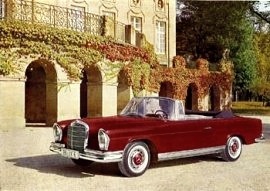 |
|
 |
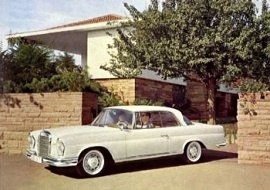 |
|
 |
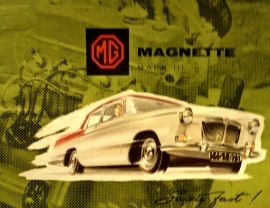 |
|
 |
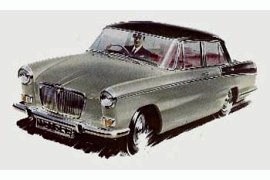 |
|
 |
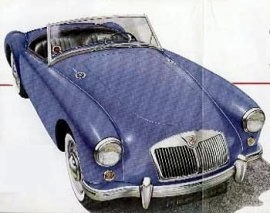 |
|
 |
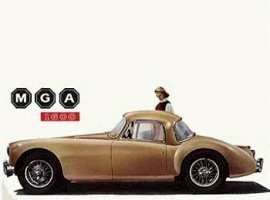 |
|
 |
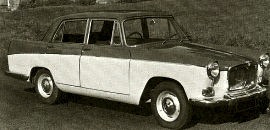 |
 |
MG Magnette Mark III Farina Saloon |
| |
Also see: MG Car Reviews | The MG Story | The History of MG |
| |
The MG Magnette Mark III 'Farina' Saloon succeeded the Magnette ZB Saloon early in the year. As with the other BMC models in this class the body was styled by Pininfarina ; it was distinguishable mainly by its traditional MG radiator grille. The 1½-liter engine had twin carburetors and developed 66·5 bhp at 5200 rpm. |
|
 |
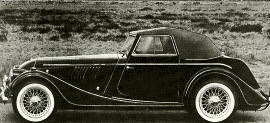 |
 |
Morgan Plus Four Drophead Coupe |
| |
Also see: Morgan Car Reviews | The History of Morgan |
| |
The Morgan Plus Four Drophead Coupe was continued with a number of changes which included the spare wheel recessed in the sloping tail, a rear-mounted 12-gallon fuel tank, and narrower running boards. These modifications also applied to the two-seater Tourer. The four-seater Tourer was also continued. Disc brakes became optional on all models. |
|
 |
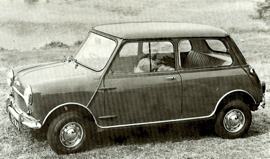 |
 |
Morris Mini-Minor Saloon |
| |
Also see: Morris Car Reviews and The History of Morris (AUS Edition) |
| |
The Morris Mini-Minor Saloon quickly became an incredibly successful little car, and was officially announced in August 1959, although the eager motoring press had previously sampled its delights in the spring of that year. The brain child of Alec Issigonis it featured a simple but practical two-door body with a 10 in. wheel at each corner, a transversely-mounted 848cc 34-bhp (net) engine, four-speed gearbox, front-wheel drive and all-independent rubber cone-spring suspension. |
|
 |
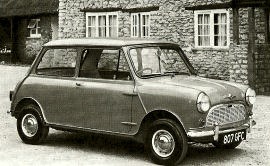 |
 |
Morris Mini-Minor Saloon |
| |
Also see: Morris Car Reviews and The History of Morris (AUS Edition) |
| |
Also available was an Austin version - then called the Seven, which was distinguishable by its different grille. Both versions were available in basic and de luxe forms, priced at £497 and £537 resp, (lncl, PT). The Austin version's name was sometimes spelled as Se7en but before long both were universally referred to as 'Mini'. |
|
 |
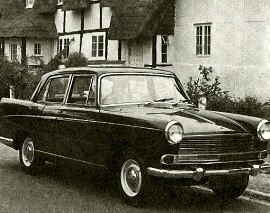 |
 |
Morris Oxford Series V Farina |
| |
Also see: Morris Car Reviews and The History of Morris (AUS Edition) |
| |
The Morris Oxford Series V 'Farina' was identical to the Austin A55 Cambridge except for radiator grille design, detail body fittings, badges and interior layout. With detail modifications it remained in production - in Saloon and Traveller form - until 1971. |
|
 |
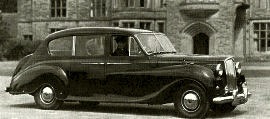 |
 |
Princess Long-wheelbase Special Equipment Limousine |
| |
Also see: Austin Car Reviews | The History of Austin (AUS Edition) |
| |
This Vanden-Plas bodied luxury Austin model (Princess Long-wheelbase 'Special Equipment' Limousine) was similar to the long-wheelbase Limousine, but included as standard fitments: automatic transmission, power steering, electrically-operated division, footrests and mohair rugs in rear compartment and an electric clock and cigar lighter for the rear-seat passengers. |
|
 |
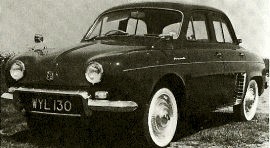 |
 |
|
| |
Also see: Renault Car Reviews | The History of Renault |
| |
The Renault Dauphine Saloon, Model R1090, was announced in France in the autumn of 1955. Iit was also assembled in the UK, at Acton, from the Summer of 1956. It was a rear-engined four-door four-seater powered by a bored-out 845-cc 30-bhp derivative of the 4CV engine and featured a unitary body-cum-chassis, three-speed gearbox and all-independent suspension. Modifications for 1959 included a raised compression ratio and a thermostatic control for the heater. |
|
 |
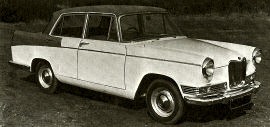 |
 |
Riley 4/Sixty-Eight Saloon |
| |
Also see: Riley Car Reviews | The History of Riley |
| |
The Riley 4/Sixty-Eight Saloon was one of the new BMC 1½-liter 'Farina' range of models. It was mechaniccally similar to the MG Magnette Mark III, but was easily distinguishable by its traditional Riley-style radiator grille. |
|
 |
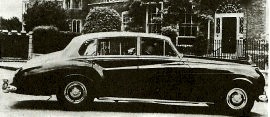 |
 |
|
| |
Also see: Rolls-Royce Car Reviews | The History of Rolls-Royce |
| |
The RolIs-Royce Silver Cloud Long-Wheelbase Saloon was a Park Ward conversion of the elegant steel saloon, lengthened to suit the 4-inch increase in wheelbase. The car was designed for dual-purpose use viz. as a limousine, chauffeur driven, with the electrically-operated glass division raised, as well as for holiday/pleasure motoring when the division could be lowered. The side windows were also electrically-operated. |
|
 |
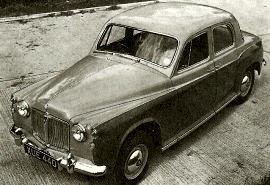 |
 |
|
| |
Also see: Rover Car Reviews | The History of Rover (AUS Edition) |
| |
The Rover 60 or Sixty P4 Saloon was continued with detail modifications which included a modified grille and a redesigned rear number plate mounting. These changes also applied to the 75, 90 and 105 models - the 105R had been discontinued in the summer of 1958 and the 105S became known as the 105 until it was also dropped, later in 1959. |
|
 |
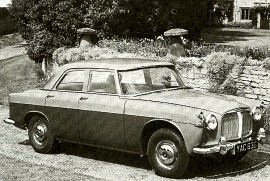 |
 |
|
| |
Also see: Rover Car Reviews | The History of Rover (AUS Edition) |
| |
The Rover 3-liter (P5) Saloon was the first Rover to have a unitary body-cum-chassis structure, albeit with a front sub-frame. It was noticeably longer, lower and wider than the other Rover Cars and featured a six-cylinder 2995-cc 115-bhp engine, four-speed gearbox and servo-assisted brakes. The front and rear bench seats had folding arm rests and were trimmed throughout in leather; separate front seats were optional. |
|
 |
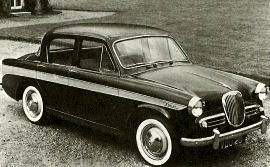 |
 |
|
| |
Also see: Singer Car Reviews | The History of Singer |
| |
The 1959 Singer Gazelle Series III Saloon was distinguishable from the Series I1 version by the reshaped body side-flashes, with 'Gazelle' located on the top of each flash near the headlamps. Convertible and Estate versions were also available. |
|
 |
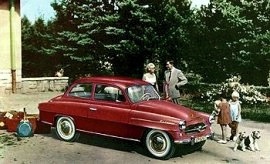 |
 |
Skoda Octavia |
| |
Also see: Skoda Car Reviews | The History of Skoda (AUS Edition) |
| |
The Skoda Octavia was introduced in January 1959, being the successor to the Škoda 440/445 on which it was based. The new Skoda was given the name "Octavia" as it was the eighth car produced by the nationalised Skoda company. The saloons would remain in production until 1964, when they were replaced by the Škoda MB1000/1100. The Octavia featured redesigned front axles with a coil spring and telescopic shock absorbers rather than a leaf spring as in the 440. The 1270 kg (2800 lb) saloons were sold with 1089 cc engines producing 40 bhp (30 kW), later 50 bhp (37 kW), and 1221 cc engines with 45-55 bhp (34-41 kW). The slightly heavier estates weighed in at 1365 kg (3009 lb), and were all shipped with 1.2 liter engines. The top speed was 110-115 km/h (68-71 mph). |
|
 |
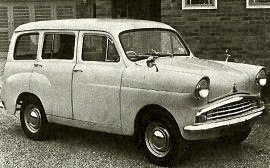 |
 |
Standard Ten Companion Estate |
| |
Also see: Standard Car Reviews | The History of Standard |
| |
The Standard Ten Companion Estate was continued with a number of styling changes which included a grille of three horizontal bars incorporating combined sidelights and flashing trafficators, and wings which were extended to form hoods for the headlamps. |
|
 |
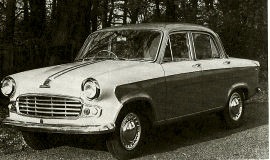 |
 |
Standard Vanguard Vignale Saloon |
| |
Also see: Standard Car Reviews | The History of Standard |
| |
Although the Standard Vanguard Vignale Saloon was mechanically similar to its predecessor - the Vanguard Phase Ill - this new model featured subtle body changes made by the Italian stylist Michelotti (in conjunction with Vignale). including a higher roof line, larger windows, a new radiator grille flanked by front lights set in chrome extensions, and modified rear light clusters. The Vanguard Estate Car featured similar changes. |
|
 |
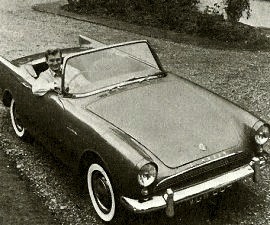 |
 |
|
| |
Also see: Sunbeam Car Reviews | The History of Sunbeam |
| |
The Sunbeam Alpine was an attractive new two-seater high-performance open sports car, featuring a number of components developed from those of the Sunbeam Rapier, including a 1494-cc twin-carburetor 78-bhp engine and independent coil spring and wishbone front suspension. When not in use the folding hood disappeared completely into a recess behind the rear 'occasional' seat. White-wall tires and wire spoke wheels were optional extras, as was a detachable hard-top. |
|
 |
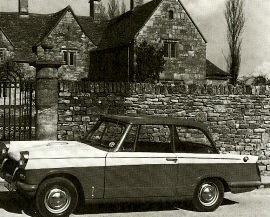 |
 |
|
| |
Also see: Triumph Car Reviews | The History of Triumph |
| |
The Triumph Herald Saloon was styled by the Italian Giovanni Michelotti. Highly successful, it included many interesting and desirable features, such as all-independent suspension, a turning circle smaller than that of a London taxi cab, a chassis without greasing points, and an all-steel body, the front section of which was hinged at the forward end to give easy access to the engine, steering gear and front suspension. The 948-cc engine and gearbox were similar to those of the Standard Ten. Also available was a Coupe version which featured a twinburettor 948-cc engine and a sloping roof line. A Convertible was launched in 1960. |
|
 |
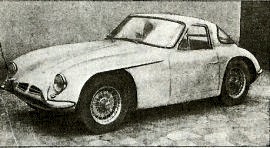 |
 |
TVR Grantura Sports Coupe / Jomar |
| |
Also see: TVR Car Reviews | The History of TVR |
| |
The TVR Grantura Sports Coupe (Jomar) was introduced onto the British market early in 1959, following a successful four-year tie-up between two Blackpool engineers, Trevor Wilkinson and Bernard Williams, and an American, Ray Saidel, during which time a number of these cars - and early models -achieved successes in American sports car events. It featured fiberglass bodywork and a choice of three power-units: Coventry Climax FWE 1216-cc (as on the Lotus Elite), Ford 100E standard or Ford 100E Super-charged. In America the car was known as the Jomar. |
|
 |
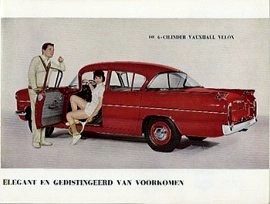 |
 |
Vauxhall Velox |
| |
Also see: Vauxhall Car Reviews |
| |
The Velox PA received its first facelift in October 1959 when the front grill was enlarged and the three piece rear window was replaced by a single wrap-around window. Technical improvements had to await the 1960 facelift. |
|
 |
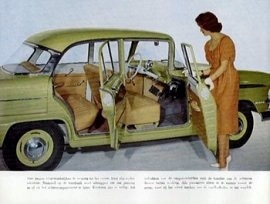 |
 |
Vauxhall Victor |
| |
Also see: Vauxhall Car Reviews |
| |
The 1959 Vauxhall Victor Series II Saloon replaced the original edition early in the year. It was distinguishable mainly by smooth rear-door panels, full-width radiator grille with protruding oval sidelights, smooth wrapround bumpers and a reshaped bonnet. |
|
 |
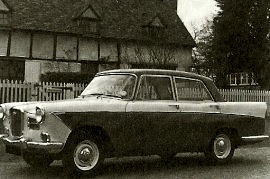 |
 |
Wolseley 15/60 Saloon |
| |
Also see: Wolseley Car Reviews | The History of Wolseley (AUS Edition) |
| |
The Wolseley 15/60 Saloon was fifth in the new BMC 1½-liter 'Farina' range and had a traditional radiator grille with illuminated name badge, flanked by horizontal air inlets. It was basically similar to the Austin A55 and Morris Oxford Series V, but not available in estate car form. |
|
|
